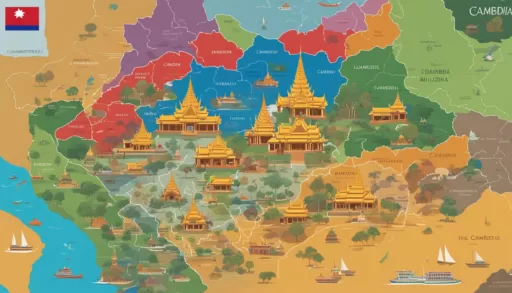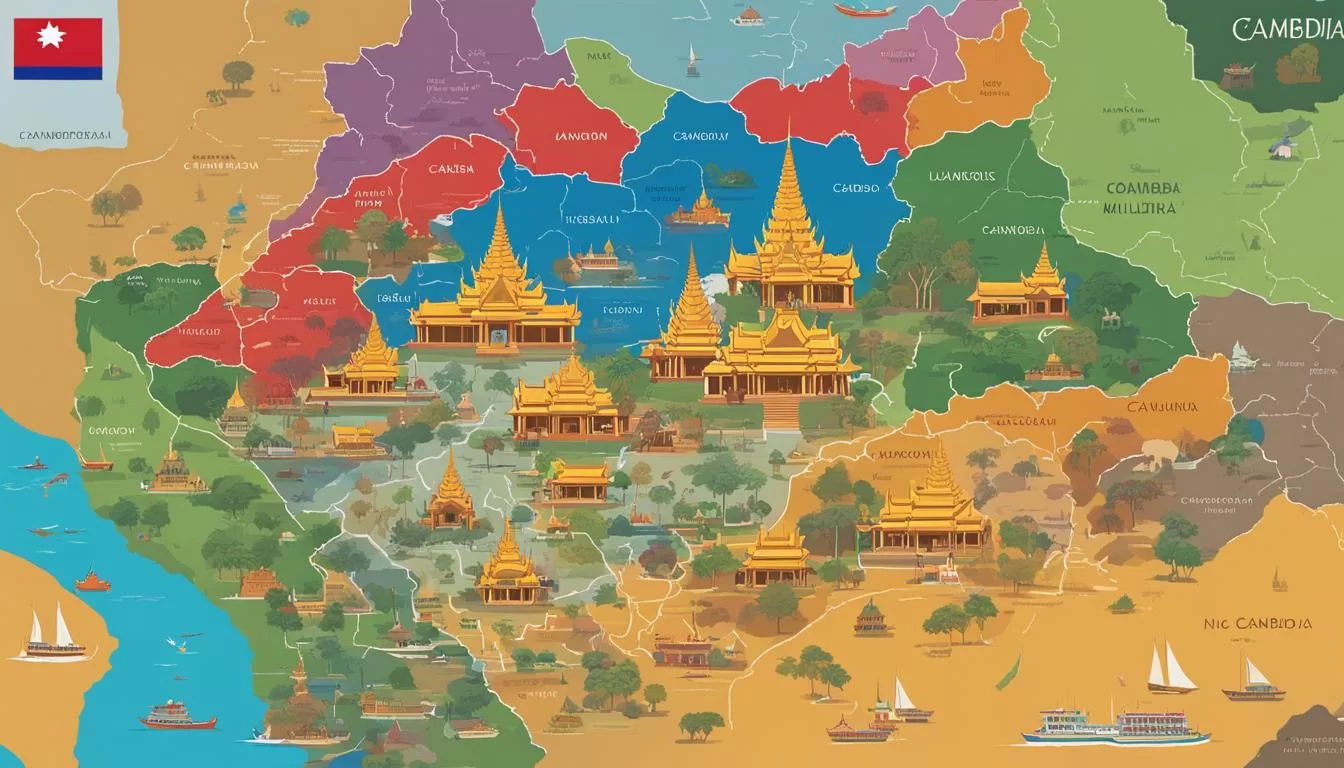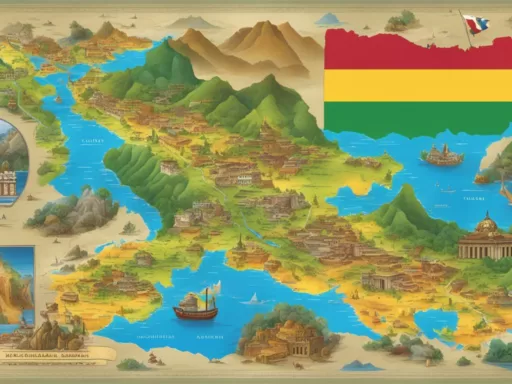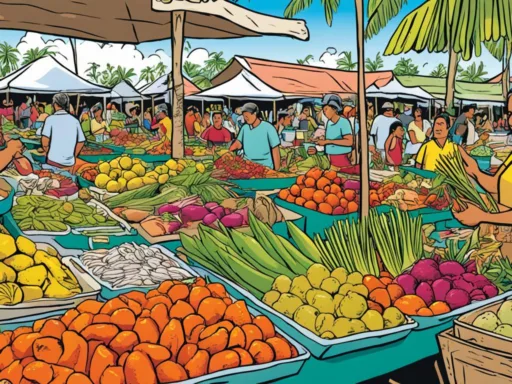When one thinks of Cambodia, the magnificent ruins of Angkor Wat and the bustling streets of Phnom Penh often come to mind. But beneath the surface of its cultural landmarks, Cambodia harbors a vivid linguistic landscape. As a nation with nearly 13 million inhabitants nestled in the heart of Southeast Asia, Cambodia’s voices resonate with the depth of its history and the diversity of its people. The core of this resonance is the official language, Khmer, an Austroasiatic tongue that has been the heartbeat of the Cambodian ethos since the time of ancient empires.
However, the narrative of the languages spoken in Cambodia doesn’t end with Khmer. Threaded throughout the population are dialects and languages such as Cham, Vietnamese, Tumpoon, and Lao, each adding their distinctive hue to the nation’s linguistic mosaic. The influence of foreign tongues like English and French also persists, echoing Cambodia’s historical ties with global partners. This interplay of languages not only underscores Cambodia’s rich heritage but also its evolving identity in a globalized world.
This introduction unfolds the layers of Cambodia’s linguistic fabric, guiding us through the nexus of communication that defines its society. From the Khmer spoken by the majority to the linguistic imprints of its minority groups and international relations, understanding the languages spoken in Cambodia offers insights into a country that is both steeped in tradition and dynamically engaging with the present.
Key Takeaways
- Khmer is the official language of Cambodia, spoken by the majority of its residents.
- Linguistic diversity in Cambodia reflects its rich cultural heritage and historical influences.
- Minority languages such as Cham, Vietnamese, and Tumpoon contribute to the nation’s unique linguistic landscape.
- English and French continue to play significant roles due to historical ties and globalization.
- Understanding the variety of languages spoken in Cambodia is key to appreciating its cultural complexity and evolving identity.
The Prevalence and Significance of the Khmer Language
At the heart of Cambodia’s national identity lies its official language, Khmer, a linguistic thread woven through the fabric of daily life and culture. As the dominant voice of the official languages Cambodia has, its resonance is heard from the rice fields in the countryside to the kinetic energy of the cities. Part of the Austroasiatic languages, Khmer echoes the annals of history and is a vital aspect of Cambodia’s uniqueness in the regional mosaic of Southeast Asia. This language is integral to the collective memory and future of the Cambodian people, contributing significantly to the linguistic diversity Cambodia is celebrated for.

Origins and Classification of Khmer
Delving into the origins of the Khmer language Cambodia cherishes, we encounter its ancient roots influenced by Sanskrit and Pali, primarily through Hinduism and Buddhism. Historically, Khmer is known as the earliest recorded and written language in the Mon-Khmer family, a lineage that has elevated it to its current prominence among Austroasiatic languages. While some linguists have previously categorised Khmer within the eastern branch of Mon-Khmer languages, today’s scholarly consensus affirms its distinct branch within the family tree, a testament to its unique linguistic evolution.
Dialects within Cambodia and the Diaspora
The echoes of the Khmer Empire’s prestige are not only confined to the boundaries of modern-day Cambodia. Variants of the Khmer language have spread across regions, resulting in fascinating Cambodian dialects spoken in parts of Thailand and Vietnam. Inside Cambodia’s borders, Central Khmer is predominantly spoken, yet there’s a wealth of diversity with dialects that span the Phnom Penh region to the remote Cardamom Mountains. Notably, Cambodian linguistic diversity also encompasses minority languages Cambodia hosts, enriched by vibrant ethnic communities and their cultural heritages.
Khmer Script and its Characteristics
The scriptural art of Khmer language Cambodia uses today has its origin story in the ancient Brahmi script. Evolved over centuries into what’s now known as the Khmer script, it is uniquely identified by subscripted consonants and the absence of a tonal system commonly found in nearby languages. It is not merely a method of communication but also an anchor of cultural significance and identity. Additionally, adaptations such as Khmer Braille have been developed, furthering inclusivity and ensuring that the linguistic treasures of Cambodia can be shared by all.
Linguistic Diversity in Cambodia
While the Khmer language is the cornerstone of communication in Cambodia, the nation’s linguistic portfolio is far more diverse. The language diversity Cambodia exhibits is a reflection of its intricate ethnic tapestry. From the bustling markets in Phnom Penh to the serene villages in Ratanakiri, each region sings with its own linguistic melody. Indigenous languages Cambodia nurtures within its borders stand as a powerful reminder of the country’s rich history and cultural complexity.

- The Central Khmer dialect, prevalent throughout the country, serves as the lingua franca for the Cambodian populace.
- Northern Khmer, primarily found in Thailand, and Southern Khmer, spoken in Vietnam, showcase the historical spread of Cambodia’s influence.
- The distinct cadence of Western Khmer echoes through the remote hills of the Cardamom Mountains, ensuring that even the most isolated communities contribute to the linguistic quilt.
Adding to this linguistic palette, minority languages like Vietnamese reveal the stories of immigrant communities who have shaped parts of Cambodian society. Reminiscent of the ancient maritime empire, the Cham language is still spoken by descendants of the Kingdom of Champa. Moreover, the sounds of the Tumpoon language reverberate within the valleys of the Ratanakiri Province, exemplifying the unique voices of Cambodia’s indigenous peoples.
Each language encapsulates a galaxy of stories and traditions, nurturing a collective memory that embraces diversity and ensures the survival of a kaleidoscopic cultural heritage.
Such a vast array of speech patterns and dialects not only enhances the cultural fabric of the nation but also poses an intriguing subject for linguists and culture enthusiasts alike. From scholars to wanderlust travelers, the linguistic diversity Cambodia offers is a vibrant realm waiting to be explored and understood.
Foreign Languages Influencing Cambodia

As Cambodia navigates through its post-colonial narrative, the enduring prominence of French language Cambodia commands a dignified spot. While it may be seen as a vestige of the French Indochina era, the French language persists within the corridors of Cambodia’s educational institutions and legal spheres, reflecting the deep-rooted ties that continue to influence contemporary Cambodian society. Notably, the older generation reminisces about French as a cornerstone of administrative discourse; thus, maintaining the practice of this foreign language merges respect for tradition with the exigencies of modern governance.
Meanwhile, the linguistic tides have shifted towards the English language Cambodia experience, particularly since its adoption in 1993 as a member of ASEAN. English has swept across the urban and rural landscapes alike, readily apparent on road signs, currency, and as the language of international diplomacy. It’s not merely a foreign language but rather an essential cog in the mechanics of Cambodia’s globalization journey – a fact that resounds in the day-to-day encounters within its cities and villages.
To contrast and illustrate the dynamics of these foreign influences on Cambodia’s linguistic landscape, consider the following table which reflects their roles and areas of prominence:
| Language | Areas of Influence | Educational Presence | Cultural Significance |
|---|---|---|---|
| French | Legal system, academia | Schools and universities funded by the French government, older curriculum models | Historical ties, older generation’s fluency, diplomatic courtesy |
| English | Diplomacy, commerce, navigation | Majority of schools, universities, and private education centers | Global communication, media, and international trade |
The harmonious coexistence of the foreign languages Cambodia embraces signifies a society that respects its history while concurrently reaching towards a future of enhanced connectivity and mutual understanding. This respect is not merely symbolic but is entrenched in the policies that buttress these languages in various sectors—a gesture that speaks volumes of Cambodia’s commitment to bridging cultures.
With the mélange of cautionary appreciation for the old and enthusiastic embracing of the new, Cambodia’s linguistic journey serves as a canvas reflecting its storied past and forward-thrusting present.
Languages Spoken Cambodia: Minority and Indigenous Tongues
The mosaic of languages in Cambodia paints a vivid portrait of the nation’s social and cultural dimensions. In this landscape, minority languages Cambodia holds dear are not residual echoes from the past but living, breathing embodiments of cultural heritage Cambodia continues to celebrate. These languages, from the melodic Cham to the nuanced vernaculars of the Mon-Khmer ethnic groups, are essential threads in the fabric of the nation’s identity.
These indigenous languages Cambodia carefully nurtures are a robust testament to its rich ethnolinguistic diversity. With governmental support Cambodia strives to strengthen, the relationship between language and cultural heritage becomes ever more pivotal. This section throws light on the efforts to preserve these languages and the challenges that come with it.
Minority Languages Preserving Cultural Heritage
The tapestry of Cambodian cultural heritage is intricately woven with the threads of its minority languages. Languages like Cham, once the lingua franca of the mighty Champa civilization, still thrive in the heart of Cambodia, connecting the Cham people with their ancestral roots. Similarly, the Vietnamese and Tumpoon languages offer rich narratives of history and tradition, reinforcing the cultural pride of their speakers.
Tribal languages such as Lao, Yue Chinese, and Jarai are more than just means of communication; they are repositories of folklore, cosmology, and collective wisdom passed down through generations. It is in the sustained vibrancy of these languages that the true essence of cultural diversity and heritage is reflected.
By cherishing each unique linguistic voice, Cambodia ensures that the stories, traditions, and identities of all its people are honored and sustained.
Governmental Recognition and Support for Minority Languages
The harmonious blend of ethnicities within Cambodia has prompted a growing awareness of the importance of linguistic preservation. Recognizing this multicultural reality, the government of Cambodia has taken steps to ensure that these voices do not fall silent. The incorporation of indigenous languages in educational materials and the provision of resources for minority language research attests to this institutional commitment.
One such initiative is the governmental facilitation of language standardization for educational purposes, which aims to foster linguistic inclusion and cultural continuation. However, the journey is not without its challenges. The case of the Khmer Krom in Vietnam, for instance, highlights the complexities of language advocacy across national borders.
Despite such obstacles, the acknowledgment and promotion of minority languages in Cambodia signal a promising trajectory towards an inclusive and culturally rich society.

The table below provides a concise overview of some prevalent minority and indigenous languages within Cambodia, their usage among ethnic groups, and examples of governmental support initiatives.
| Language | Usage Among Ethnic Groups | Governmental Support Initiatives |
|---|---|---|
| Cham | Used primarily by Cham ethnic communities | Inclusion in historical studies and cultural programs |
| Vietnamese | Spoken by Vietnamese communities in Cambodia | Support for language classes and cultural exchange events |
| Tumpoon | Indigenous to the highlands in Ratanakiri Province | Development of educational materials in Tumpoon language |
| Lao | Common in communities near the Cambodia-Laos border | Preservation projects in partnership with Lao-speaking regions |
| Yue Chinese | Spoken by the Chinese-Cambodian diaspora | Maintenance of Chinese-Cambodian schools and cultural associations |
| Jarai | Used by the Jarai minority in northeastern Cambodia | Recording and documentation of oral histories and traditions |
Conclusion
As we reflect upon the linguistic landscape Cambodia offers, it becomes apparent that the fabric of this nation is richly embroidered with the threads of numerous languages, each significant in preserving the cultural identity Cambodia holds dear. With the dominant Khmer language leading the chorus of diverse vernaculars, the polychromatic array of minority and indigenous tongues secures the historical continuity and collective wisdom of Cambodia’s people. In a world where the global tide can erode linguistic heritage, the emphasis on language preservation Cambodia actively upholds becomes not only a shield against cultural dissolution but also a celebration of its intricate identity.
The Importance of Language Preservation for Cultural Identity
In these efforts to sustain nuances of regional speech, language preservation in Cambodia is more than a mere academic or aesthetic endeavor; it is an act woven into the very essence of cultural identity Cambodia has developed over millennia. Each language serves as a vessel, containing the distilled essence of stories, customs, and perspectives that, collectively, communicate the soul of Cambodia to the future. Thus, safeguarding these linguistic treasures is integral to ensuring that the rich tapestry of Cambodian culture, with its patterns of history and tradition, is appreciated by generations to come.
Cambodia’s Linguistic Landscape as a Reflection of its History
The linguistic landscape of Cambodia is a living museum, showcasing signs of an evocative history that has witnessed the grandeur of Angkorian civilization and the dynamism of contemporary life. From the ancient corridors of Angkor, where the Khmer script decorates stone in silent grandeur, to the vibrant streets of modern-day Phnom Penh, where English has gained prominence, every script and utterance reflects the layered narrative of this resilient nation. In this seamless blend of ancient and modern, of native and foreign, the narrative of Cambodia is interwoven into a linguistic quilt that narrates its past, reinforces its present, and whispers to its future.
FAQ
What languages are spoken in Cambodia?
In Cambodia, the primary language spoken is Khmer, which is the official language. There are also a number of minority and indigenous languages including Cham, Vietnamese, Tumpoon, Lao, Jarai, and Yue Chinese. English and French are foreign languages that are widely spoken.
What is the significance of the Khmer language in Cambodia?
The Khmer language is of significant cultural and historical importance to Cambodia. It is the official language and is spoken by the majority of the population. It has ancient origins and is closely connected to Cambodia’s heritage, being the mode of communication since the times of the Khmer Empire.
How does the Khmer language classify among other languages?
Khmer is a member of the Austroasiatic language family and is classified as part of the Mon-Khmer language group. It is the second most widely spoken Austroasiatic language after Vietnamese.
Are there different dialects of Khmer language?
Yes, there are several dialects of the Khmer language. These include the Phnom Penh dialect, Northern Khmer in Thailand, Khmer Krom in Vietnam, and a conservative dialect found in the Cardamom Mountains. These dialects are mutually intelligible to a degree.
What are the characteristics of Khmer script?
The Khmer script is an abugida system with subscripted consonants and two series of consonants for different inherent vowels. Khmer language is non-tonal and emphasizes the final syllable of words, using subject-verb-object word order, and particles and auxiliary words instead of inflections to express grammatical relationships.
How diverse is the linguistic landscape in Cambodia?
Cambodia’s linguistic landscape is very diverse. Besides the central Khmer dialect, there are minority languages spoken by various ethnic groups, as well as a significant presence of foreign languages like French and English.
Which foreign languages have influenced Cambodia?
French and English have deeply influenced Cambodia. French was historically significant during the Indochina period and is still used, particularly by older generations. English has become predominant since 1993 and is used broadly in business, education, and international relations.
What minority languages are spoken in Cambodia?
In Cambodia, minority languages include Vietnamese, spoken by immigrants; Cham, associated with the historic kingdom of Champa; as well as various indigenous Mon-Khmer languages spoken by the country’s ethnic groups.
What is the Cambodian government’s stance on minority and indigenous languages?
The Cambodian government recognizes the need to support linguistic diversity within its borders. While Khmer is the official national language, there is a growing awareness and effort to preserve minority and indigenous languages as they are a vital part of the country’s cultural heritage.
Why is language preservation important for cultural identity in Cambodia?
Language preservation is crucial for maintaining cultural identity in Cambodia. Each language holds the history, traditions, and wisdom of its people, and preserving these languages is integral to upholding the rich cultural tapestry of Cambodia for future generations.
How does Cambodia’s linguistic landscape reflect its history?
Cambodia’s linguistic landscape reflects its rich and diverse history, from the ancient Khmer script found in temple inscriptions to the modern use of English in international affairs. The variety of languages spoken today are testaments to Cambodia’s historical grandeur and its ongoing regional and global interactions.






